As Black Friday approaches, the frenzy of shopping and deals is about to hit its peak. For marketers, this is the perfect moment to captivate your audience with standout email campaigns that cut through the noise. But with so many promotions flooding inboxes, how do you ensure yours stands out?
In this blog, we’re diving into some of the best Black Friday email examples that not only captured attention but also drove impressive results, plus trends, steps for success, the various types of Black Friday campaigns, and more.
- Black Friday: the Super Bowl of email marketing
- 5 successful Black Friday email campaigns
- Anticipating 2024 Black Friday trends
- What makes a Black Friday email campaign successful?
- How to create high-performing Black Friday email campaigns
Black Friday: the Super Bowl of email marketing
Black Friday is one of the busiest and most anticipated times of the year for email. Over half of consumers are eager to jump on early sales and promotions, making Black Friday a prime opportunity to achieve email’s 36:1 ROI potential.
With Black Friday shopping early on shopper’s minds, your email list is a great place to meet prospects where they’re at. They raised their hands to hear from you by subscribing to your email list, so they’re primed to buy.
The average consumer is expected to buy more this year, with holiday retail sales likely seeing a moderate increase between 2.3% and 3.3% as consumers continue to deal with inflation.
“Although the pace of increase in holiday sales will be slower than last year, we expect that healthy growth in disposable personal income (DPI), combined with a steady labor market, will support a solid holiday sales season.”
—Akrur Barua, Deloitte Insights
November is the best month for engagement, and it sets the stage for this high-stakes season. With the right holiday email marketing strategy, you can score big.
Let’s dig into some examples.
5 successful Black Friday email campaigns
Exploring a variety of Black Friday email campaigns can help uncover what strategy will work best for your goals. Below, we’ve sourced examples for email inspiration that showcase both creativity and results.
Kate Spade: Harnessing first-party data for Black Friday success
First-party data is individual-level data collected from your audience, using on your own channels. With elements like live polls, email becomes a rich medium for collecting first-party insights from your audience.
As part of a recent Black Friday email campaign, Kate Spade sent two Black Friday emails: one to capture first-party data, and a second email that acts on it.
The first email included a Litmus Personalize Live Poll, plus a progress bar made up of spades:
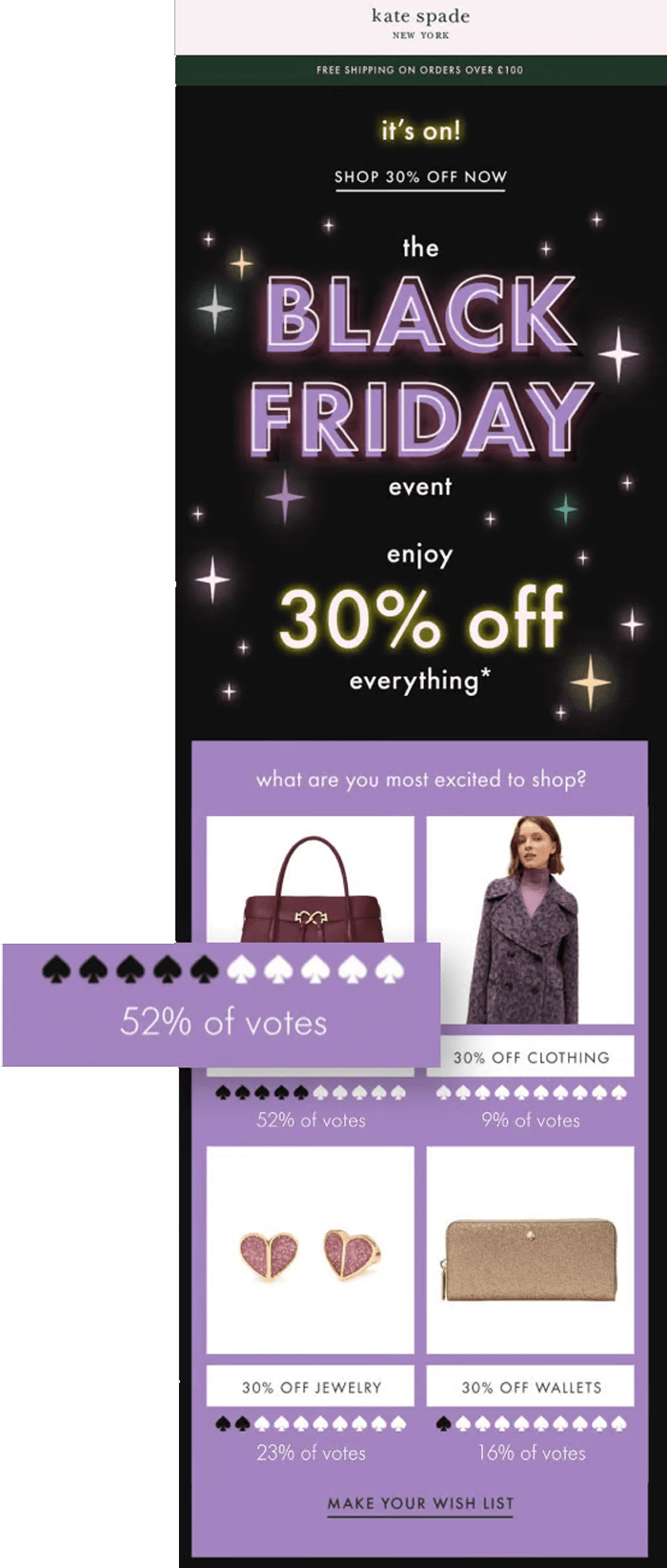
Subscribers voted with a simple click—increasing the email’s click-through rate (CTR) while simultaneously capturing first-party data. Votes were updated each time a subscriber opened the email.
After the 24-hour mark, Kate Spade sent a follow-up email, segmenting based on subscribers who voted for a particular category. Subscribers received an email with in-stock products based on their vote—and those who didn’t vote received an email containing best-selling items.
“We increased CTR using the poll in email one and then had a bigger pool of engaged people to send a targeted, click-based follow-up to. This was a great strategy that really worked!”
—Performance Marketing Manager, Kate Spade
The results spoke for themselves:
- 84% increase in click-through rates (CTR)
- 12% increase in overall CTR
- 47% increase in revenue
- 140% growth in users year-over-year
Endy: Leveraging social proof in Black Friday emails
People trust people, and the power of social proof harnesses this very aspect. It can be done elegantly and simply with the help of Litmus Personalize Interest Signals—like Endy has done as part of their Black Friday email design, below.
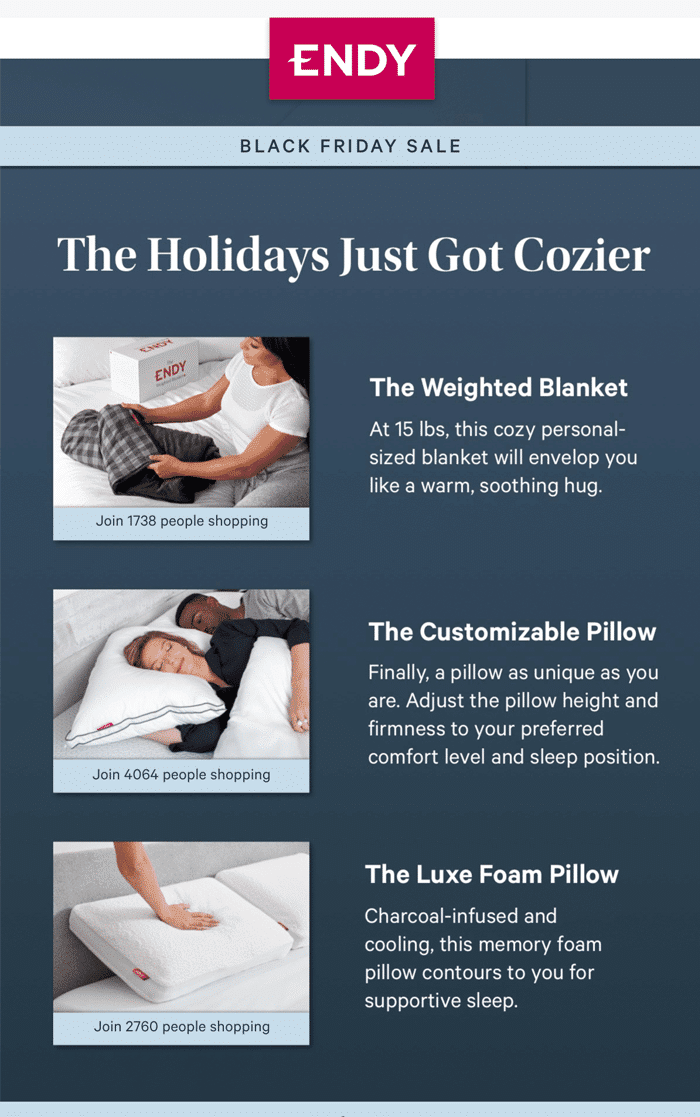
Each product image displayed the total number of clicks, positioned as “Join X people shopping” to drive FOMO and get subscribers to take action. These numbers only displayed after a certain amount of clicks were reached, updating each time a subscriber opened for real-time insights.
“This email is just so effortless. It includes subtle social signals, with visibility rules which can be set by the user so that they only show after a certain number of clicks.”
—Martyn Lee, Marketing & Email Design Specialist, Litmus
Not only do Interest Signals boost engagement; they have been proven to consistently result in higher click-through and conversion rates.
- 25% increase in total opens
- 180% more orders vs. control
- Over 190% more revenue vs. control
- 26% increase in revenue
Hunter: Creating urgency for a Black Friday promotion ending
The ticking clock is a powerful symbol that triggers a sense of urgency. During Black Friday, where promotions are limited-time offers, consider incorporating countdown timers as a visual cue in your emails.
Hunter’s Cyber Monday email includes a countdown timer:
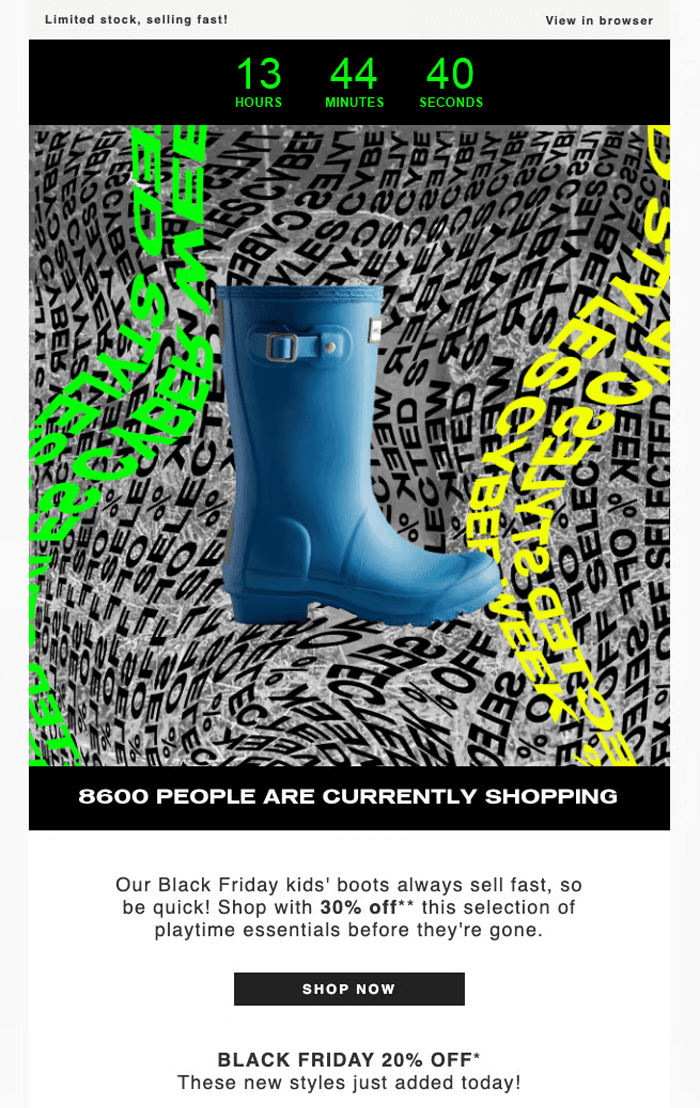
42% of consumers feel excited by banner ads featuring a countdown timer, and this same principle can be applied to your Black Friday email strategy.
Hard Core Waterfowl: Creating flexible email templates for the holidays
The holiday season can be a bit of a hectic time for email marketers. Keeping flexibility in mind for your holiday email marketing strategy will pay dividends.
MH Digital Consulting Group was brought on board to help Hard Core Waterfowl just one month before Black Friday to overhaul their email marketing program. They focused on refining the email and content strategy, designing a versatile email template that allowed for agile and ad-hoc adjustments to messaging.
This approach ensured that Hard Core Waterfowl could easily adapt their communications and respond effectively to changing needs during the busy holiday period.
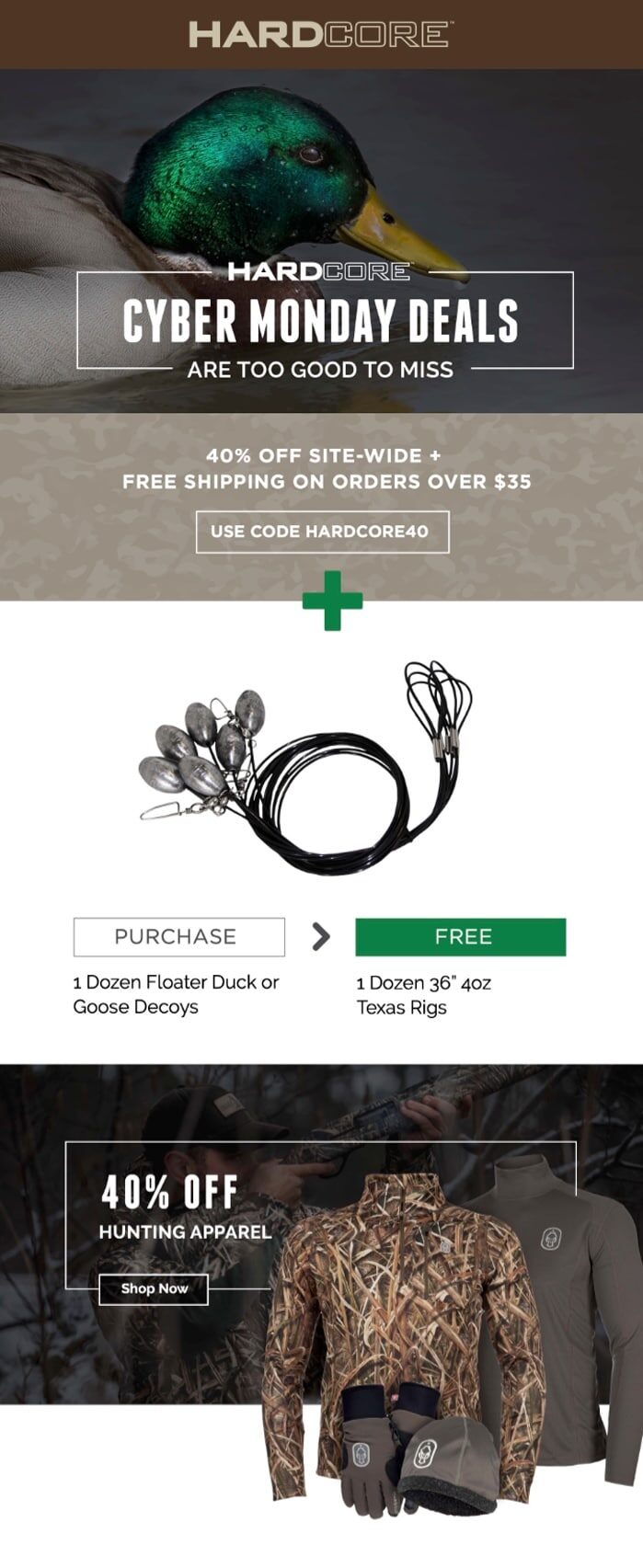
Black Friday generated over $50,000 in sales directly attributed to email.
Maniology: Automating with a browse abandonment flow
Meeting subscribers where they are in the customer lifecycle can make a significant impact—especially with email automation as part of your strategy. Browse abandonment emails, for instance, are particularly effective in guiding prospects from the consideration phase to checkout.
Email marketing agency CodeCrew worked with Maniology to revamp their browse abandonment series. They refined the flow with richer content, crafted a strategic journey to entice customers back to the site, adjusted triggers to bring them back sooner, and updated the designs to showcase more of Maniology’s product offerings—garnering a 196% increase in revenue, in six months.
Along with creating this new browse abandonment flow, their designs played an important role in increasing Maniology’s Black Friday sales by over 100%. (And that’s not even counting Cyber Monday.)

Anticipating 2024 Black Friday trends
What’s Black Friday trends are expected to hit the inboxes this BFCM season? Litmus’ Angie Weyman took a look into her crystal email geek ball for three themes:
- Sustainability.
 Expect more brands to spotlight sustainable products, eco-friendly packaging, and even “Green Friday” deals. Look for emails with minimalist designs that reduce the carbon footprint (which helps with deliverability and the user experience, win-win-win!)
Expect more brands to spotlight sustainable products, eco-friendly packaging, and even “Green Friday” deals. Look for emails with minimalist designs that reduce the carbon footprint (which helps with deliverability and the user experience, win-win-win!) - Accessibility.
 Brands are making sure their BFCM emails are inclusive for everyone, with bigger fonts, high-contrast colors, and screen-reader friendly designs. ALT text? Check. Cleaner layouts? Yes. Everyone gets a seat at the holiday table.
Brands are making sure their BFCM emails are inclusive for everyone, with bigger fonts, high-contrast colors, and screen-reader friendly designs. ALT text? Check. Cleaner layouts? Yes. Everyone gets a seat at the holiday table. - User-generated content (UGC).
 More brands letting their customers do the talking, by showing off real reviews, photos, and videos in emails. Genuine community vibes build trust with subscribers and makes the user experience feel truly personal.
More brands letting their customers do the talking, by showing off real reviews, photos, and videos in emails. Genuine community vibes build trust with subscribers and makes the user experience feel truly personal.
“I see a strong focus on going green, being inclusive, and keeping it real. Email marketers are looking for more ways to focus on sustainability with eco-friendly email structure, making their emails accessible for everyone, and leaning into user-generated content for that authentic, community-driven vibe.”
—Angie Weyman, Product Marketing Manager, Litmus
Here are more trends we expect to see across holiday email campaigns.
Mobile-first email design approach
According to our latest data, from Thanksgiving to New Year’s Day, over 44% of emails were opened on mobile devices, and generally speaking, 60% of emails are viewed on mobile devices.
This shift is prompting retailers to focus on mobile-specific strategies, including calls-to-action (CTAs) designed for tapping and larger CTA buttons positioned above the fold. We’ll also continue seeing single-column, responsive templates optimized for mobile.
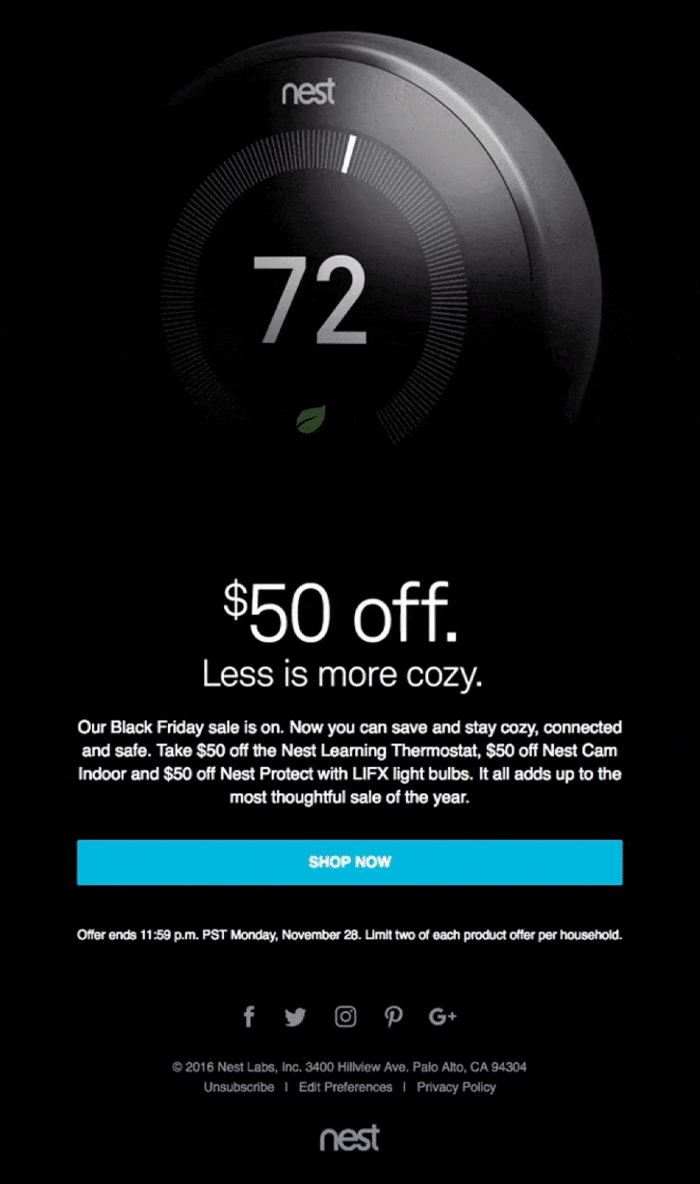
Mobile commerce is booming; in 2023, mobile devices accounted for 54% of online sales, with Black Friday purchases up 10.4% from 2022, according from Experian. More consumers are using their phones for shopping, making it crucial for marketers to ensure their mobile sites and emails offer an optimized, seamless experience.
If you’re not already optimizing for mobile, now is the time to address any issues. Use responsive email templates to ensure your content displays consistently across all devices and deliver mobile-friendly emails with every send.
Anti-Black Friday campaigns
This trend isn’t new, but it’s been gaining momentum over the past few years. Pioneered by outdoor brands like Patagonia and REI, these bold email marketing campaigns address larger societal issues and resonate with younger consumers eager to break away from tradition.


Shoppers, especially during the holiday season, prefer buying from brands that give back. According to Deloitte:
- 63% of Gen Zs and millennials believe businesses have the power to influence social equality.
- 62% of Gen Zs and 59% of millennials have reported feeling anxious about climate change in the past month.
- 25% of Gen Zs and 24% of millennials have reduced or stopped purchasing from businesses with unsustainable supply chains.
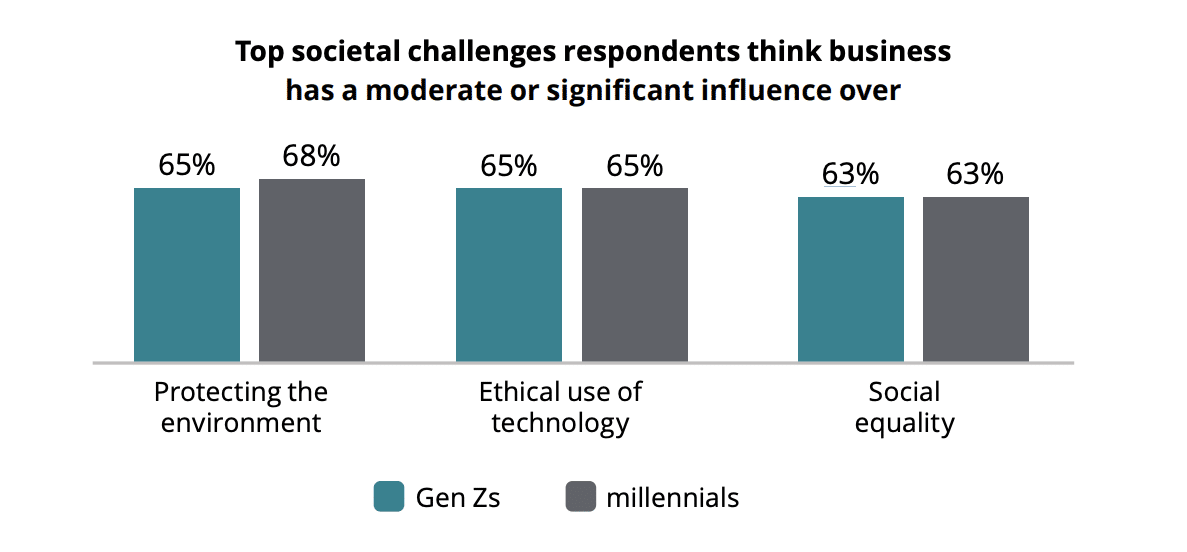
Given these concerns, it’s no surprise that we’re seeing a rise in campaigns questioning the very premise of Black Friday. After all, isn’t Thanksgiving about being grateful for what we already have? As sustainability and social responsibility become more important to consumers, we expect these types of thought-provoking campaigns to gain even more traction this year.
Dark Mode-friendly email designs
Dark Mode isn’t just accessible—it’s also an effective way to showcase products with clean, monochromatic designs, without too many bells and whistles.
In the early days of email, designs mimicked web pages, complete with navigation bars, drop shadows, and glossy buttons. Today, retailers are streamlining their approach, choosing substance over flash.
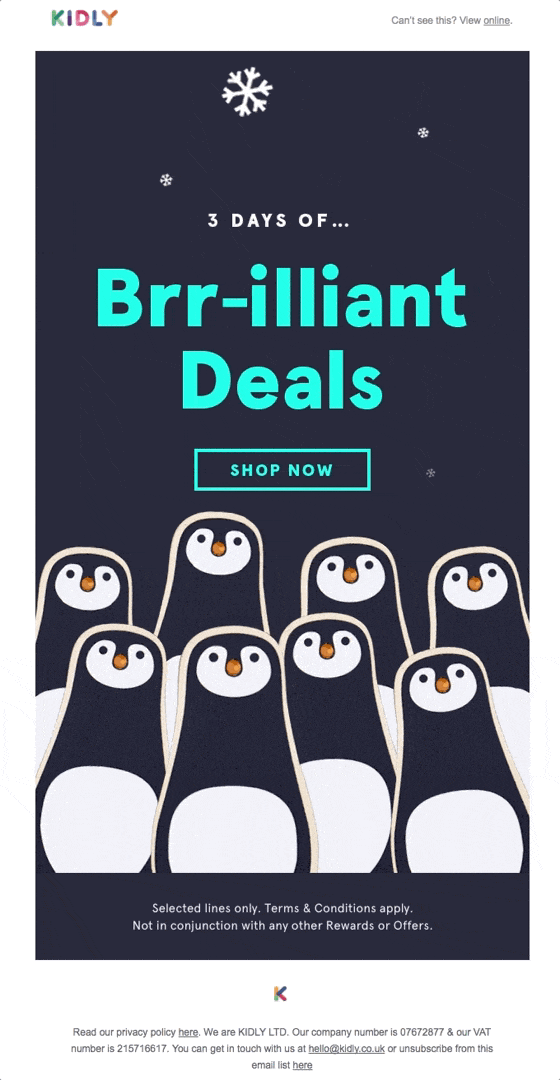
As a bonus, these minimal designs are Dark Mode-friendly. With 35.4% of email opens happening in Dark Mode, it’s crucial to ensure your emails are easy to read and engage with.
Dark Mode uses light typography on dark backgrounds, so designing with a black-and-white color scheme ensures your message remains clear, even if the email client reverses the colors.
On top of that, designers are increasingly considering digital sustainability: making creative choices that are both eco-friendly and accessible to all.
Countdown timers
Countdown timers are a no-brainer for Black Friday—time and deals are limited, and this simple feature can drive urgency and a sense of FOMO.
We expect to see countdown timers as a major trend again this year, especially as a crossover trend from eCommerce stores.

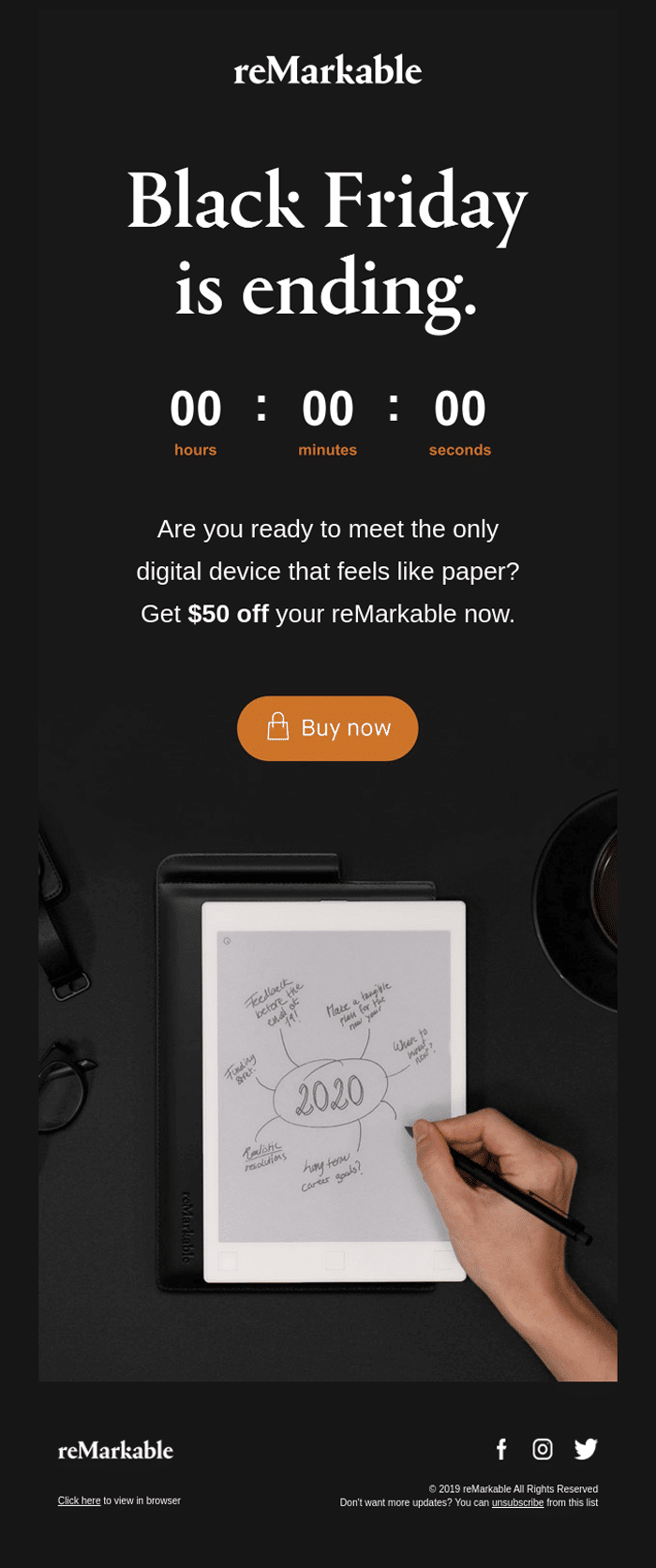

They’re effective at motivating customers to take action, as the visual cue of a clock ticking down on a deal creates a sense of urgency that’s hard to ignore.
Early access campaigns
Consumers know and love Black Friday—and this year, we predict retailers will go even bigger. Expect more “pre-sale,” “sneak peek,” and “early access” teaser emails designed to build excitement and exclusivity.

According to the National Retail Federation (NRF), 43% of shoppers typically start their holiday shopping before November. Their top reasons are:
- Spreading out their budget (60%)
- Avoiding last-minute stress (46%)
- Dodging the crowds (45%)
These early shoppers could be further influenced by October sales events. In fact, the NRF reported that last year, seven in ten holiday shoppers considered taking advantage of October deals for holiday gifts, décor, and other essentials.
Key factors driving an earlier Black Friday start
Amazon recently confirmed its second Prime Day sale on October 8 and 9, kicking off the 2024 holiday shopping season. Major retailers like Best Buy, Walmart, and Target will be launching competing sales.
Nonetheless, while your subscribers expect Black Friday deals, they may hold out for bigger discounts (e.g. around Christmas time), so timing matters.
What makes a Black Friday email campaign successful?
Align objectives with department & company goals
Your Black Friday email marketing campaign needs to support larger organizational objectives. Make sure your goals—whether increasing revenue, clearing inventory, or customer acquisition—are clear from the outset.
Show you know your email subscribers with segmentation
One can argue there’s no such thing as too many emails—just poor segmentation. Instead of “blasting the list,” refine your Black Friday campaigns to cater to the different pockets of your email list.
A great Black Friday email campaign will have a thoughtful segmentation strategy. Look into any existing insights you have on your audience, whether that’s nested in your email service provider (ESP) or a tool like Litmus Email Analytics for advanced insights, like read rate and top email clients among your subscriber base. Then, define your target audience.
Segmentation can be based on:
- Purchase history. Recent buyers, high-value customers, occasional shoppers, or haven’t purchased
- Engagement level. Active openers, frequent clickers, dormant subscribers (e.g., clicked an email in the past two weeks vs. six months ago)
- Demographics. Age, occupation (if relevant to your products), and location.
- Preferences. Product categories, content types, communication frequency
- Zero-party data. Information customers intentionally share with you (e.g., preferences, interests)
- First-party data. Data collected directly from your interactions with customers (e.g., purchase history, website behavior, or an email live poll)
- Webinar or event attendance. If they’ve attended something you’ve hosted recently, they could be great candidates for sending targeted campaigns.
- Timing. This begs the age old question: when should you send an email? You can look into historical data on your best open times, but keep in mind that your subscriber is likely receiving a high volume of emails during this time. Timing can also depend on a few things—for example, if your sale is set to give 12pm local time, you might send a one hour reminder per region or time zone.
Once you’ve defined your segments, consider where you can incorporate email personalization to foster a 1:1 experience in the inbox. Automation and product feeds unlock a whole new level of tailored email content, especially when it comes to email personalization for eCommerce.
Create compelling offers
It’s not just about a catchy subject line. Your Black Friday offer must stand out. Think irresistible discounts, exclusive bundles, or early access to deals. Make sure the promotion resonates with your target customers.
- Showcase your best discounts. Offer significant savings, such as 30% off sitewide, $20 off purchases over $100, or free shipping on all orders.
- Create special offers with bundles. Create special product bundles available only during Black Friday, like “buy one, get one free” or “three for the price of two.”
- Early access to deals. Provide VIP early access to sales for subscribers or loyal customers, allowing them to shop before the general public.
- Limited-time flash sales. Run flash sales with deep discounts that last only a few hours to create urgency and drive quick purchases.
- Remind email subscribers of deadlines. Include “doors closing” or “last chance” messaging in your email copy.
- Free gifts with purchase. Include a free gift with purchases over a certain amount, such as a free tote bag with orders over $75.
- Buy more, save more. Implement tiered discounts where customers get a higher Black Friday discount with larger purchases, like 10% off orders over $50, 20% off orders over $100, etc.
- Take advantage of the Black Friday weekend. While you may wrap up your Black Friday promotions shortly after your “final hours” emails, remember to consider Cyber Monday sales as part of your promo plan (e.g. a sales extension for Cyber Monday).
Grammarly’s Black Friday promo was the best offering of the year: 55% off for users that switched to an annual plan—front and center with an attention-grabbing hero image.
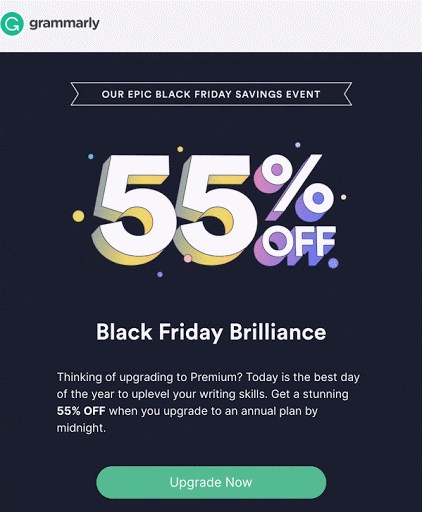
The Washington Post takes a similar approach, with an early-access Black Friday offer of four weeks for less than a dollar. The special offer is placed prominently in the hero section in red, contrasting with the black background to grab reader’s attention. The call-to-action button copy “Act now” is succinct and actionable.
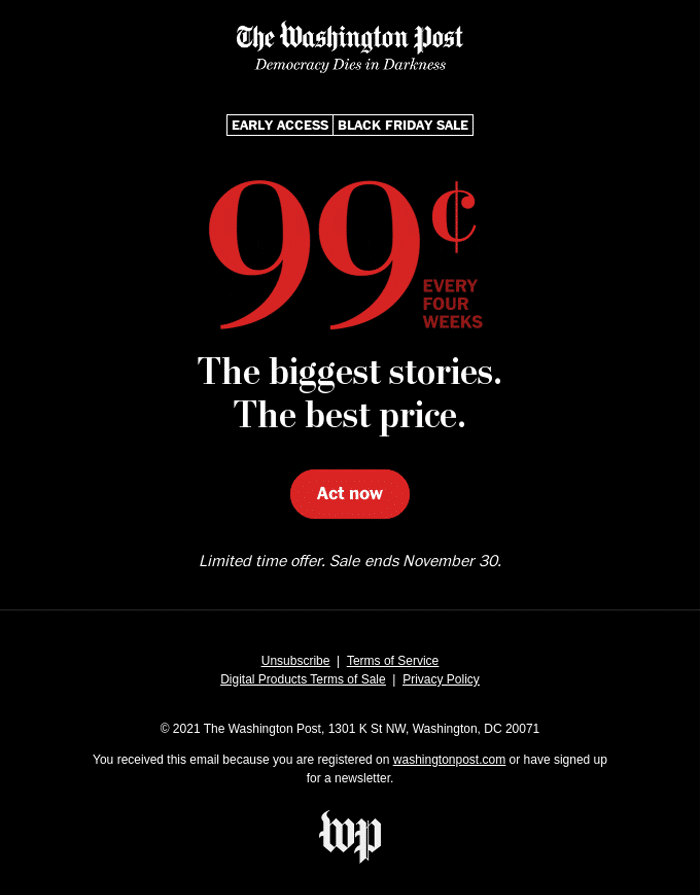
Operational excellence
On average, email teams take two weeks or more to create a single email. That means everything from strategy, copy, design, code, segmentation, QA testing, approvals, and hitting send. Needless to say, there’s a lot on an email marketer’s plate.
During this busy season, being agile and flexible is essential. Having a streamlined email workflow will yield benefits not only during Black Friday, but well beyond.
Run a quick audit of your workflow to identify areas that take up most of your time and consider ways to simplify. Your future self will thank you!
According to The State of Email Workflows, the biggest obstacle for email marketers in the email production cycle is collecting feedback. It’s a pain point for leaders, too: 17% of email marketing leaders cite collecting feedback and approvals as one of their biggest frustrations.
Here are some strategies to help you move your best come Black Friday:
- Prepare your Black Friday email templates. This includes design, building, making them Dark Mode ready, and QA testing—reducing the need for last-minute fixes and email errors.
- Centralize feedback in one place. An email collaboration software like Litmus Proof can help centralize feedback in one place—avoiding the email threads, Slack messages, and the time consuming back-and-forth that can occur with collecting feedback. (Some teams save up to five hours a day with it!)
- Explore integrations that work with your ESP. The average marketer uses over twelve technologies to manage their email program. Integrations—like ones with Litmus—help you move swiftly and seamlessly.
- Keep a pre-send email checklist handy. This helps keep your workflow in check and empowers you to know that you hit “send” with everything in place.
Testing and optimization
While Black Friday presents huge opportunities, a broken email can significantly diminish your chances of converting—and might even lead to an unsubscribe or worse, spam. 86% of customers will leave a brand after only two poor experiences.
Common issues to watch out for:
- Images not loading or appearing broken
- Unsupported HTML or CSS
- Custom fonts not displaying
- Layout issues on mobile
- White lines in Outlook
- Broken links and tracking
- Syntax errors
- Non-functional animated GIFs or videos
- Links showing up as blue vs. their styled color
Don’t let your marketing efforts go to waste! To avoid these pitfalls, thorough email testing is key. With email clients updating as often as every 1.2 days, consider using a tool like Litmus Email Guardian for extra peace of mind.You’ll get 24/7 monitoring and alerts you if any client updates could cause issues.
As for segmentation, don’t rely on guesswork. Leverage any available analytics, whether from your ESP or a tool like Litmus Email Analytics to see how your audience is engaging with your emails—everything from device preferences to Dark Mode usage and read time. This allows you to identify trends and refine your strategy to truly resonate with your subscribers.
How to create high-performing Black Friday email campaigns
Black Friday is a major opportunity, but standing out in crowded inboxes requires strategy. From eye-catching designs to personalized messaging, every aspect of your email needs to work together to drive results. Here’s how you can build Black Friday email campaigns that perform at the highest level.
Craft irresistible Black Friday email subject lines
Your subject line is the first thing subscribers see, so it needs to grab attention. Use urgency, exclusivity, or even a bit of mystery to boost open rates.

While email subject line best practices are important considerations to factor, don’t forget to A/B test different variations to see what resonates with your audience—like personalizing by first name, including a trendy catch phrase, or using emojis.
Learn more: Black Friday and Cyber Monday: 50+ Email Subject Lines That Convert
Personalize your offers
Most marketers rely on the basic personalization capabilities within their ESP—but this often limits them to only merge tag personalization. So if most emails start with “Hello, %%first_name%%,” is that really enough to stand out in a noisy inbox?
This is where personalization comes. We’re not just talking about text-based personalization: think bigger, with real time/open time personalization, like countdown timers, scratch-offs, social media feeds, live polls, and social proof.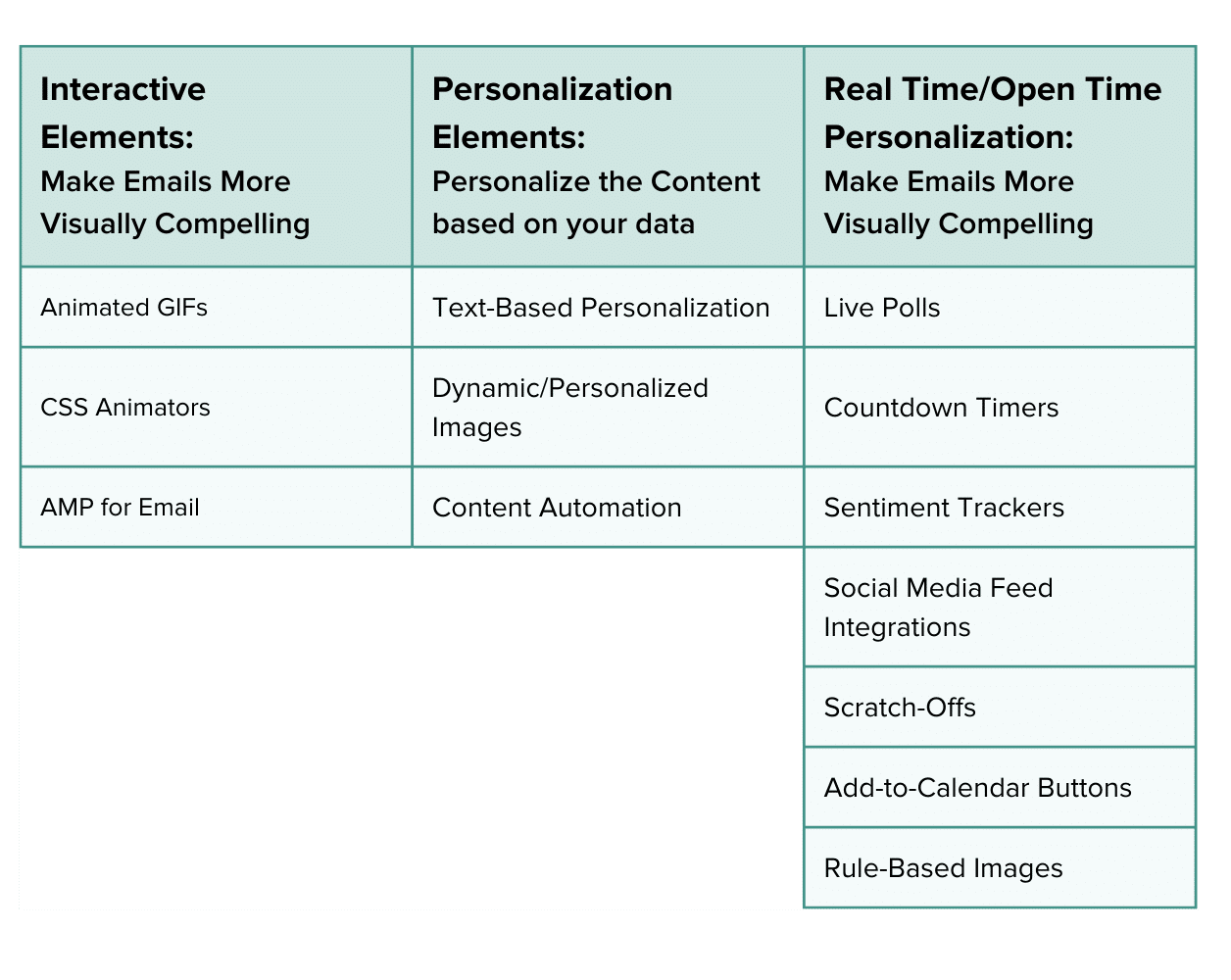
 More of a visual person? Explore real-life, dynamic email content examples over in the Email Gallery for our top picks of emails made with Litmus Personalize, that can help your brand get more clicks, more revenue, and provide better in-email experiences.
More of a visual person? Explore real-life, dynamic email content examples over in the Email Gallery for our top picks of emails made with Litmus Personalize, that can help your brand get more clicks, more revenue, and provide better in-email experiences.
Include eye-catching visuals
Visuals are key to drawing in users to take a desired action, such as CTAs in email. whether that’s a CTA to your online store or a hyperlink to a landing page. Use vibrant imagery, animated GIFs, and text styling to keep subscribers engaged.
Casper makes their 15% off offer impossible to miss. The bold blue text on a light orange background creates strong contrast, while the imagery perfectly captures the emotional satisfaction customers can expect from buying their product.
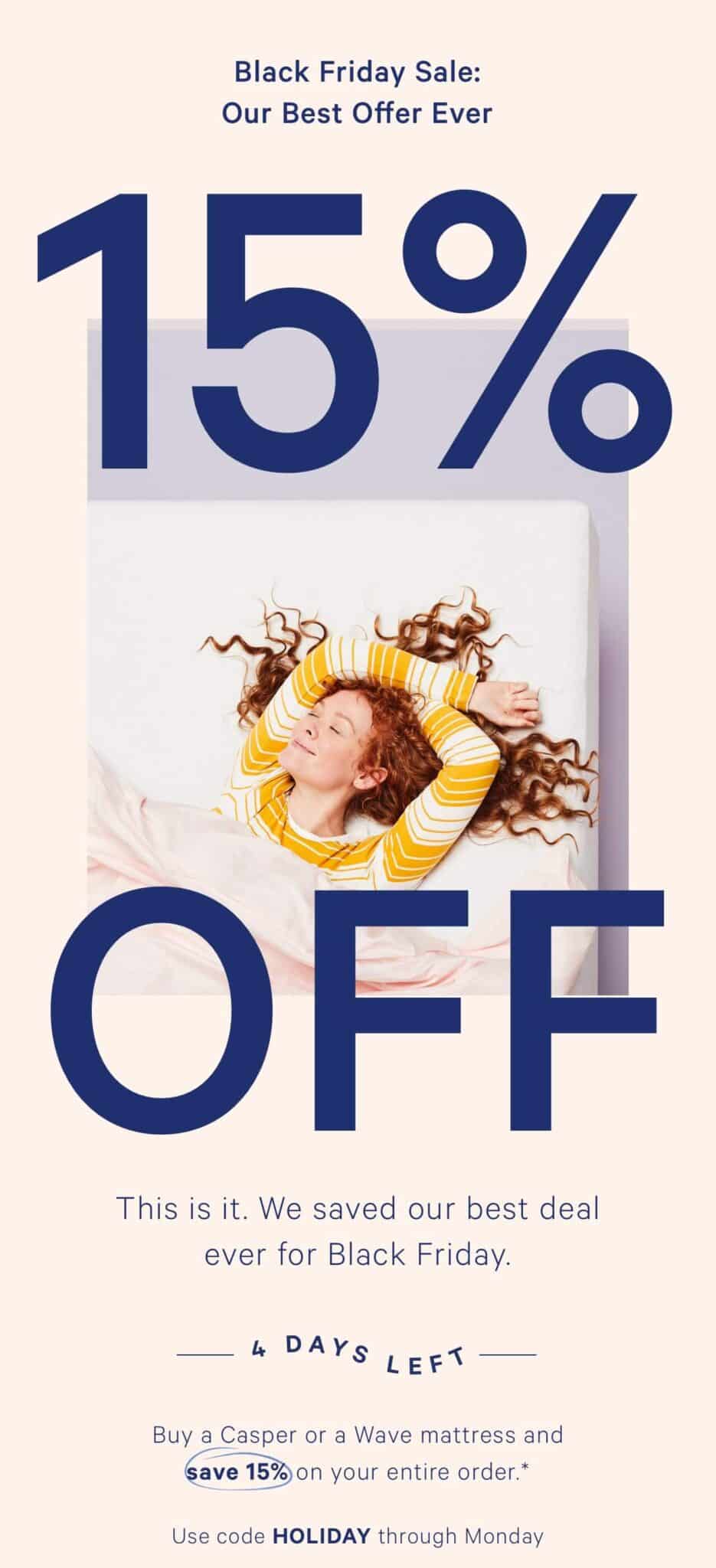
For Cyber Monday, Casper keeps their Black Friday email design above the fold: the offer is in the headline of the email Cyber Monday eve, up to 30% with the deadline to shop 3 days left in the eyebrow text. The discount code is included in the hero section of the email copy.

Leverage automation for timely follow-ups
Automation ensures you’re sending the right message at the right time. Set up triggered holiday emails, such as abandoned cart reminders or inventory alerts, to re-engage subscribers and drive sales that might otherwise be lost.
Keep your email deliverability up
Deliverability is the final factor in an email cycle: it’s important to keep and maintain healthy deliverability so yours emails reach your customers. Litmus Spam Test scan your emails against 20+ different spam filters so you won’t skip a beat.
You’ve got Black Friday in the bag!
With Black Friday shopping early on shopper’s minds, now is the time to fine-tune your email marketing strategy. With the right approach, you can engage eager customers, drive revenue, and make this Black Friday your most successful yet. Don’t wait—start planning early to capture the excitement and maximize your holiday sales.
The post Top 5 Black Friday Email Campaigns & Winning Strategies appeared first on Litmus.
https://www.litmus.com/blog/black-friday-email-marketing-strategy-guide